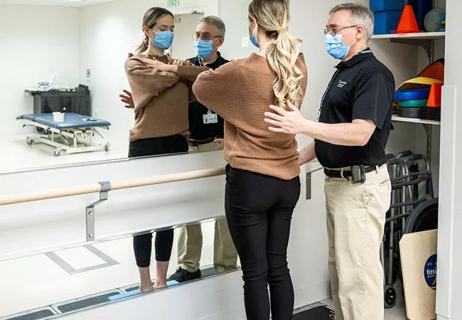Expanded patient criteria and surgical advances mean more patients can benefit
Since establishing its Hearing Implant Program in 1983, Cleveland Clinic has placed more than 2,000 cochlear implants.
Advertisement
Cleveland Clinic is a non-profit academic medical center. Advertising on our site helps support our mission. We do not endorse non-Cleveland Clinic products or services. Policy
“We’re committed to making sure every individual who needs a cochlear implant has access to one,” says Sarah Sydlowski, AuD, PhD, MBA, audiology director of the Hearing Implant Program and associate chief improvement officer at Cleveland Clinic. “Today, only about 2% of people who can benefit have one, and so we’ve worked really hard as a program over all of those 40 years – but especially in the most recent years – to make sure we’re constantly innovating.”
In a recent episode of Cleveland Clinic’s Head and Neck Innovations podcast, Dr. Sydlowski and Marc Bassim, MD, medical director of the Hearing Implant Program and section head of otology and neurotology at Cleveland Clinic, share information about the program and advances in cochlear implants. They discuss:
Click the podcast player above to listen to the episode now, or read on for a short edited excerpt. Check out more Head and Neck Innovations episodes at clevelandclinic.org/podcasts/head-and-neck-innovations or wherever you get your podcasts.
Podcast host Paul Bryson, MD, MBA: What's changed when you look at doing implant surgery with the electrodes or with hearing preservation or even the approach to the insertion of that? Can you share a little insight into how things have changed?
Advertisement
Dr. Bassim: There has been quite a bit of change in the way we do the surgery. This has been driven in part by our understanding of what gives us better outcomes for the patients and also by the evolving candidacy. Now we're not just dealing with patients who are profoundly deaf. We're dealing with patients who have residual hearing, and sometimes we need to preserve that residual hearing to be able to use it in the case of combined stimulation.
So, the surgical field has evolved, of course, in terms of making it an easier surgery. It is a same-day surgery. It takes about two, two-and-a-half hours all included, and then the patients go home the same day. There's minimal pain after that, and the complication rate has gone down dramatically. But also in terms of the special techniques you mentioned. The electrodes have evolved over time.
We have different kinds of electrodes, so choosing the kind of electrode is one of the decision points we have to make along the selection of the decision criteria for the patient – how we approach the cochlear. It used to be that as long as you get to the cochlear, you just open the cochlear somehow and insert the electrode. Twenty years ago, that's all that mattered. Now we know that it's not just where you do that opening. [It’s] how you approach, how you insert the electrode, how fast you insert the electrode, which techniques you use in that. All that matters big time in terms of getting better outcomes.
So, the electrodes have gotten slimmer, they've gotten less traumatic. We have new advances in terms of robotics that potentially allow us to insert the electrode very slowly and minimize the trauma. We have intra-cochlear measurements. There are quite a few changes that are happening in the field that allow us to refine the surgery and the outcome for these patients.
Advertisement
Advertisement

Study shows no negative impact for individuals with better contralateral ear performance

Recommendations look to change mindset with CI referrals

Research on children with UHL explores the quality-of-life benefits and outcomes of cochlear implants

Detailed surgical process uncovers extensive middle ear damage causing severe pain and pressure.

When a patient failed to improve, the value of a comprehensive vestibular test was apparent

Case study illustrates the potential of a dual-subspecialist approach

Evidence-based recommendations for balancing cancer control with quality of life

HNS device offers new solution for those struggling with CPAP